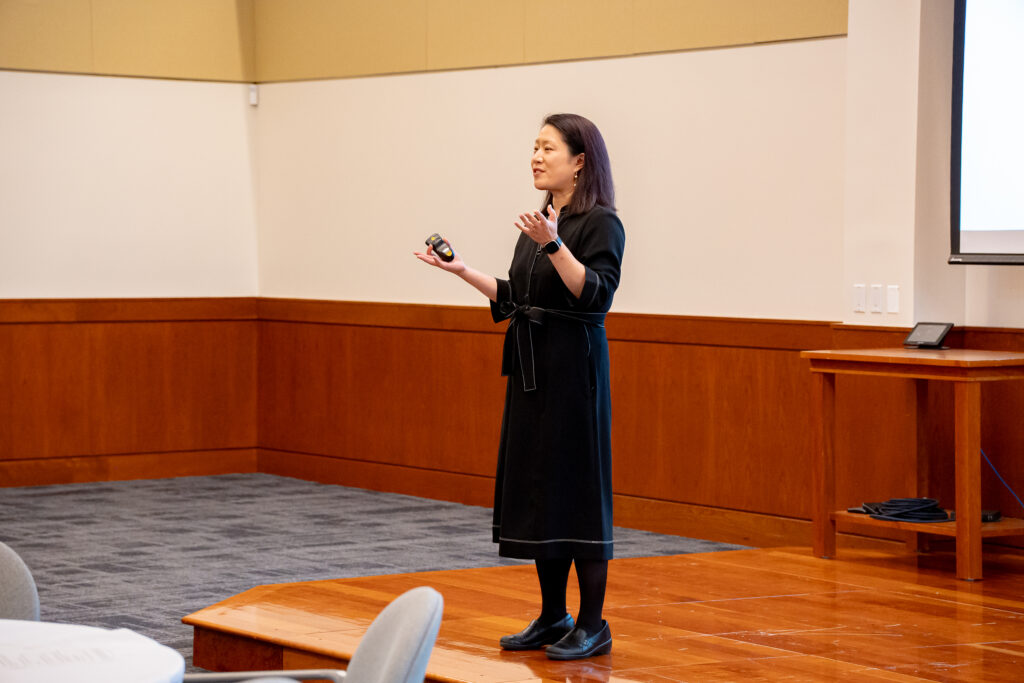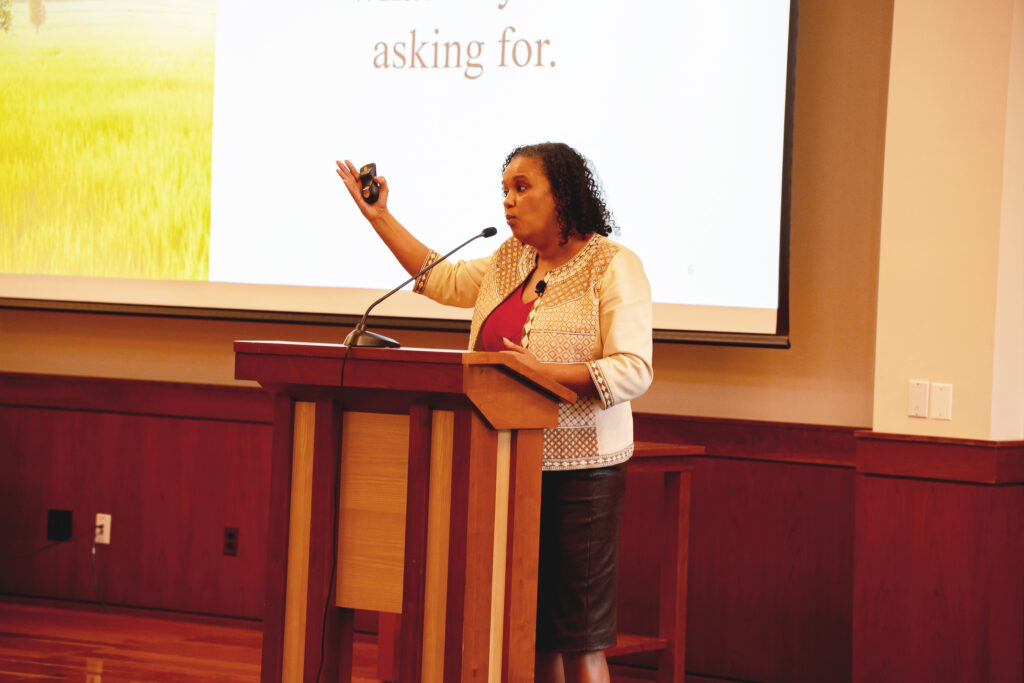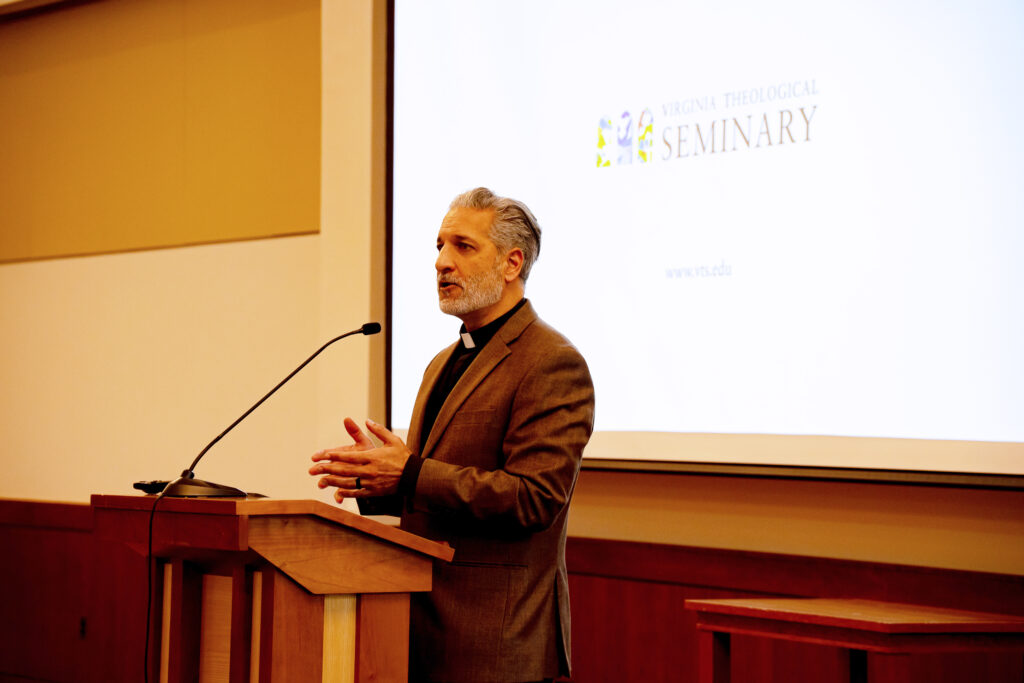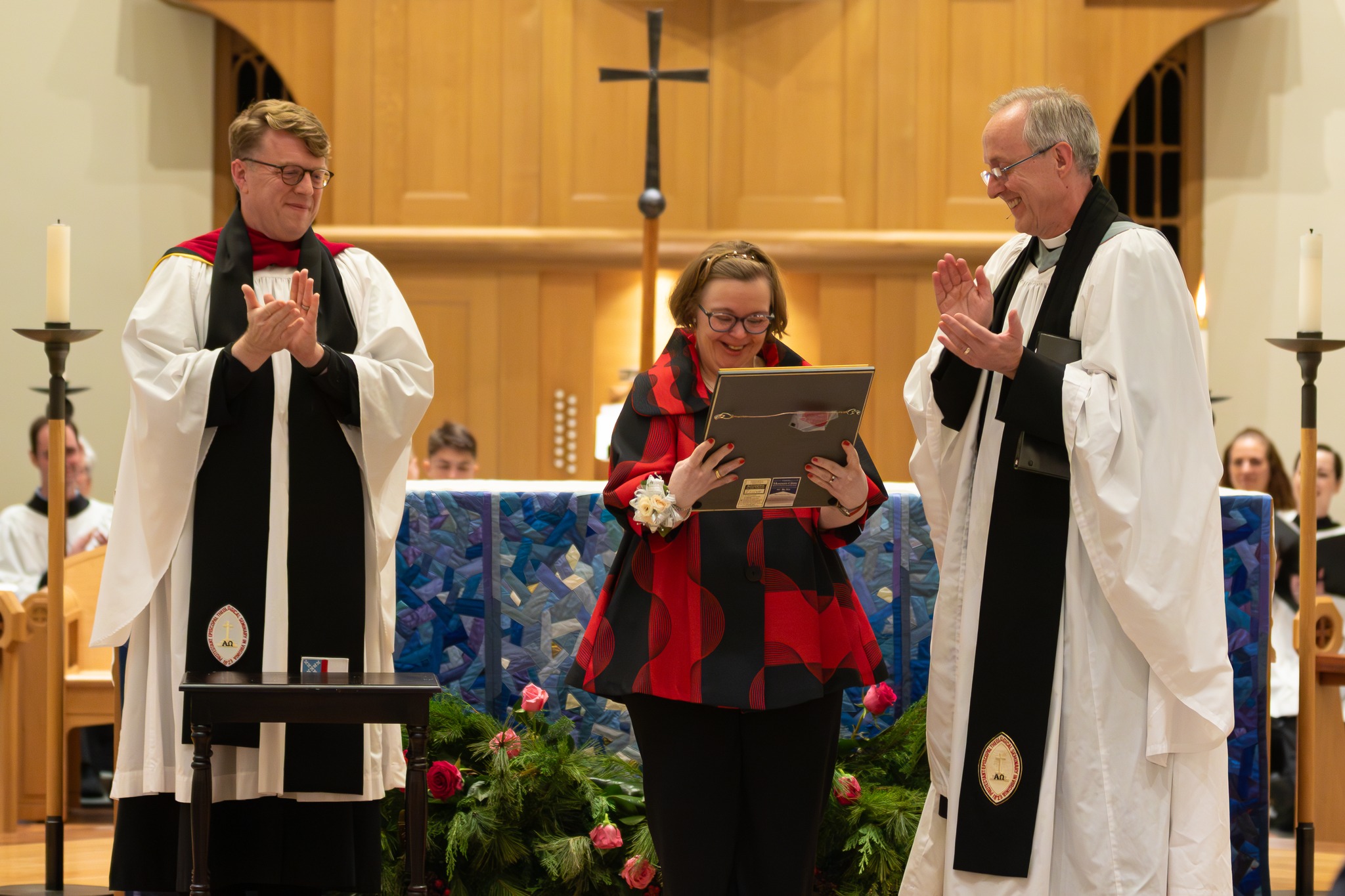
The Ministry of Mitzi Budde
Mitzi Budde, D.Min, Head Librarian and the Arthur Carl Lichtenberger Chair for Theological Research, retires after 33 years. The Rev. A. Katherine Grieb, Ph.D., ’83, reflects on the profound impact she has had on VTS.

Together we make The Episcopal Church stronger

At a Philanthropy Symposium marking the retirement of Vice President for Institutional Advancement Linda Dienno, four experts explored how evolving community needs, emerging technologies, and faith-based perspectives are shaping fundraising.
For Anna Barber, President and Principal Consultant at Barber & Associates, fundraising starts with articulating the work an organization does for society to make transformative change. “It’s not about the money. It’s about the actual work, and how you articulate and communicate that work in a clear, concise, and compelling way because it’s the work that speaks volumes,” she said.
She explained that when planning a campaign, she advises fundraisers to start with an aspirational vision of the role their organization will play in solving a problem or challenge, looking at what they want to achieve from a long-term strategic perspective, where they want to make investments and how much they need to raise in order to do that work.
A key part of this aspirational vision is having a very clear mission statement that summarizes the organization’s strategic decisions, program development, resource allocation, and overall direction, she explained. Barber gave the example of Human Rights Watch’s mission statement: Defending the rights of people worldwide, pointing out that it not only described the organization’s purpose but was also concise enough for the donor audience to remember exactly what it was that the organization did. “Remember that it’s your solutions, plus donor funds, that equate to social change,” she said.
Barber said it was very important that the mission statement was also communicated internally, so that everyone in the organization knew what it wanted to achieve, and its direction, strategy and objectives were aligned. “If there’s conflicting messages coming out of your organization and they’re not clear, you begin to test the credibility of your organization in the eyes of prospective funders,” she explained.
As such, everyone internally should have a clear sense of what their organization’s core annual programs are, what it is good at, what it does on a day-to-day basis, as well as knowing its total operating budget from a revenue and expenditure perspective. “It’s very difficult to fundraise without understanding your numbers,” she said.
Next, she advised fundraisers to ensure they had evaluation metrics for their current programs to include in their case for support, as donors would want to know about impact. “Make sure you have images, make sure you have compelling stories. Make sure you have your numbers, your fundraising goals, and if you can get a stewardship structure in there, even better,” she said.
Barber also stressed that it was important to educate donors on the ways they could give, such as whether a campaign was accepting pledges over five years, or planned gifts, or gifts of personal property, or gifts from Donor Advised Funds. She added that it was also crucial to put your contact information in, as well as a QR code that went directly to your giving page.
Once a budget and a fundraising goal have been set, Barber said fundraisers needed to turn their attention to how they were going to raise the money. She suggested they do this through creating a giving pyramid to help identify how many gifts at what level were needed to reach your goal. For example, she explained that you may decide you only need 17 large gifts to reach a goal of $1 million, which means you should think in terms of building relationships with strategic donors, not reaching out to thousands of people.
Barber said fundraisers should think in terms of cultivating four prospects for every one gift they expected to close, so for 17 donors, they should plan to be in conversation with 68 people to reach their goal. She added that when fundraising targets were broken down in this way, other people in the organization, such as members of the board, were often able to identify people from their own networks who might give at this level, but if it was not broken down in this way, it was very difficult for people to help connect you with potential donors.
Finally, Barber said another crucial aspect of fundraising was ensuring you continued to engage with your donors in an effective way after they had made a gift. She suggested thinking about stewardship on the front end and building it into your annual plan, such as having a dinner with the board once a year for all donors above a certain level.

Dr. Robert Garris, Executive Director, Trinity Leadership Fellows and Managing Director, Leadership Development at Trinity Church, thinks anyone who is thinking about fundraising should understand how foundations develop their strategies and engage with local communities.
“Many leaders in churches or seminaries engage in ministry that is locally grounded, and therefore it’s important and helpful to understand how foundations go about engaging in those same local spaces,” he said.
Garris pointed out that there are more than 900 community foundations across the United States. He explained that while national private foundations could be valuable partners when there was a tight alignment of mission and goals, community foundations often served as more natural collaborators for churches and local organizations. “They tend to be closer to the ground, more deeply rooted in place, and more directly responsive to community needs,” he said.
Foundations make up a significant part of the philanthropic landscape, accounting for around 17% of total giving in the U.S. But Garris pointed out that when seeking funding from a foundation, it was important to conduct research to understand that foundation’s focus. He added that the focus was likely to be much more fine-grained than the broad categories suggested. For example, “education” could mean everything from first-generation access to higher education, to primary education and literacy, to girls’ education overseas.
“Alignment of mission between the local actor and the foundation is essential, and it’s unlikely that a pitch, or even a request for a meeting, will advance if that fine-grained alignment of interests doesn’t exist before the initial contact and is made clear in the initial contact.” He added that this research should not be limited to reading broad statements on a webpage, but rather by examining grants made in the past year.
Garris said understanding the kinds of activities foundations support was also important. Giving money to develop or expand a program was the most common form of support from foundations, but building the fundamental infrastructure of the nonprofit sector through operating support is a growing area, which accounted for 20% of foundation giving in 2021, and is likely to be even higher now, he said.
“A growing number of donors are recognizing the need for a healthy ecosystem to be able to launch creative new initiatives. You can’t do one without the other.”
A foundation’s own source of funding also often shapes how it engages with communities. Garris explained that community foundations typically collected donations from that community and redistributed them locally. In some cases, it was a single family or donor, who created the foundation, meaning they had a great deal of influence over how the money was used. In other cases, money was pooled by multiple donors for greater impact.
Many corporations also have some sort of philanthropic wing which is often focused on giving in their place, such as where they have their headquarters, or where they do a lot of its work. Beyond grantmaking, many foundations, including some community foundations, also run their own programs directly.
Garris explained that understanding governance models could also help organizations assess whether they may be able to have influence over the strategy and focus of the foundation. He said some foundations, such as the Rockefeller Foundation, were established by a single donor whose priorities still shaped the board’s decisions today. Others used more democratic models, inviting grantees or community members into strategy discussions or even into the grantmaking process itself.
“As you consider approaching a foundation to pitch your project, understanding that governance model is very helpful. It helps you think about the potential for success, partly in the moment, but also in thinking about whether you can engage somehow in shaping that foundation’s longer-term vision for the work that it does.”
Garris finished by speaking about the work of his own church, Trinity Church, in New York City. He explained that while it was a church, not a foundation, it did have significant assets which it deployed for charitable purposes both locally and globally. He added that it both made grants to other organizations and provided direct services.
In New York City, its efforts focus on racial justice and housing and homelessness, while globally it invests in leadership development and mission real estate for both The Episcopal Church and the Anglican Communion.

Artificial intelligence (AI) has emerged as a transformative force across many sectors, including nonprofit fundraising and philanthropic development. Alice L. Ferris, partner at GoalBusters Consulting, considers the current situation to be analogous to the American frontier expansion: a new territory filled with both promise and challenge.
She said frontier development could be seen as having three distinct stages: a “me” phase, when people were looking for personal gain; a “we” phase when families and communities worked for the benefit of the broader unit; and a “they” phase when communities set up institutions that would benefit those who came after them.
Ferris said the integration of AI into fundraising will likely mirror this historic progression, moving from a “me” stage in which individual fundraising professionals will utilize AI to enhance their personal effectiveness and efficiency; to a “we” stage in which organizations will implement AI systematically; to a “they” stage which focuses on establishing systems and practices that will benefit future generations of fundraisers.
She explained that integrating AI tools at the individual level was the first crucial step in technological adoption. She pointed out that AI now offered an alternative approach to content development and refinement, and it was particularly good at voice adaptation, transforming standard marketing copy into something more engaging for a particular audience. She added that AI could also be used to adjust language complexity, such as simplifying copy written by a technical expert, while preserving the core message and technical accuracy, and keeping an authentic voice.
For organizations without dedicated research teams, AI also offered efficient ways to compile and analyze publicly available information about potential donors, leaving fundraisers more time for relationship building and strategic planning. “The key lies in viewing AI not as a replacement for human judgment but as a tool that creates more space for the essential human elements of fundraising by handling routine tasks more efficiently,” Ferris said.

As the adoption of AI in fundraising moves into the “we” stage, organizations are increasingly implementing AI-powered chatbots to streamline basic donor interactions. Ferris explained that rather than replacing human connection, these tools enhanced accessibility to information and basic services, such as by providing immediate, personalized responses to common queries rather than requiring donors to navigate lengthy FAQ pages.
She said fundraisers could also use AI’s role-playing capabilities to simulate donor conversations using detailed donor profiles, allowing them to test approaches, identify potential weaknesses in their presentations, and refine their strategies before actual donor meetings.
But Ferris warned that there were several critical challenges and ethical considerations that organizations needed to be aware of when incorporating AI. These challenges included the environmental impact of AI due to the substantial computing power it requires, the danger that it inadvertently perpetuates and amplifies societal biases due to the datasets it draws on, as well as privacy and security concerns. Other issues included the potential impact on the workforce if AI replaced certain tasks, and quality control due to AI’s tendency to “hallucinate”.
To address these issues, Ferris suggests organizations should develop comprehensive policies governing AI use, including ethical guidelines for AI implementation, quality control protocols, privacy and security measures, environmental impact considerations, workforce development strategies, and bias monitoring and correction procedures.
For Ferris AI’s true value lies in how it frees fundraising professionals to focus on the uniquely human aspects of their work. For her, this represents the “they” stage of implementation. “When fundraisers are relieved of routine tasks through automation and AI assistance, they gain more opportunities to engage in deep, meaningful interactions that build individual and institutional wisdom,” she said.
She suggested that as AI applications for fundraising continue to be developed, a valuable framework for evaluation is asking whether the technology creates more space for human connection.
“Through this lens, the ‘me’, we’, ‘they’ framework takes on additional significance. Individual efficiency gains (me) and organizational improvements (we) ultimately serve to create and preserve wisdom that benefits future generations (they). By thoughtfully implementing AI tools at each stage, we create more opportunities for the human connections that transform knowledge into wisdom and make philanthropy truly meaningful,” she said.

For the Rev. Dr. Lorenzo Lebrija, chief innovation officer of Virginia Theological Seminary and the executive director of TryTank Research Institute, fundraising is not simply a financial transaction, rather it is a spiritual act rooted in invitation, conversion, community, and prayer.
Drawing on the work of Henri Nouwen and his book The Spirituality of Fundraising, Lebrija invited people to reimagine their approach to fundraising and see it as an extension of ministry rather than a necessary administrative task.
“Henri Nouwen’s approach to fundraising deeply impacted me. He had me when he said, ‘Fundraising is precisely the opposite of begging.’ And that, to me, said, ooh, maybe I can do this.”
Lebrija explained that Nouwen emphasizes a commitment that integrates spirituality into every aspect of our lives, including how we ask for money. “Fundraising is proclaiming what we believe in such a way that we offer other people an opportunity to participate with us in our vision and our mission,” he said.
Seen this way, fundraising becomes less about requesting money and more about inviting people into God’s work, he said. But to do this effectively, fundraisers need to be clear and confident about their mission.
“We have to have a very clear vision for our ministry so that we can invite others into this mission. It’s about offering inspiration, not desperation. Think about entrepreneurs. They show confidence and clarity with their ideas. They thus build trust and excitement from that clarity. We need to be just as clear on God’s desires for our world and how we can help bring this about,” he said.
He gave the example of the Rev. Doyt Conn, a modern church fundraiser in Seattle, who was told by consultants that he would not be able to raise more than $4 million for a capital campaign. Instead, by building two simple questions – “Who gave you the church?” and “Who do you want to give the church to?” – into his case for support, he raised $9.2 million. “He was inviting people into that vision of God for Seattle,” Lebrija said. He explained that it was about participation, not transaction.
Quoting from Nouwen, Lebrija said: “Fundraising from the point of view of the Gospel says to people, ‘I will take your money and invest it in this vision only if it is good for your spiritual journey, only if it is good for your spiritual health.’ What a different approach that is, to not just seeing someone as dollar signs, but I am here to minister to you, and I do this by inviting you into this.”
He pointed out that Nouwen’s idea that fundraising is really a call to conversion, applied as much to fundraisers as it did to donors. “Those of us who ask for money need to look carefully at ourselves. We will never be able to ask for money if we do not know how we ourselves relate to money.”
Lebrija explained that Nouwen challenges fundraisers to examine their own relationship to wealth and security, confronting the discomfort and vulnerability that money often provokes. “Only when we are free from money can we freely ask others to give it,” he said.
Lebrija explained that relationships, not transactions, are at the heart of this vision. “Those who need money and those who can give money meet on the common ground of God’s love.” He added that when fundraising is done in this spirit, it builds deeper community within faith contexts and reflects trust in God’s abundance rather than a fear of scarcity.
Prayer is an essential part of this transformation. “Prayer is the spiritual discipline through which our mind and heart are converted from hostility or suspicion to hospitality toward people who have money,” Lebrija said. “Gratitude is the sign that this conversion is spreading into all aspects of our life.”
He added that generosity is not limited to financial contributions, but people can also give their time, talent and their networks. “‘How can we,’ says Nouwen, ‘embrace a vision of generosity that goes beyond finances, where people are invited to give of themselves in ways that extend their own skills and talents to God’s work?’” He added that for Generation Z, this was one of the most important ways to show them that the church is authentic in its call to do the work.
Together, the symposium’s speakers showed that while philanthropy is an evolving field, it remains a deeply human practice that requires a strong understanding of impact, a thoughtful use of technology, and a grounding in spiritual purpose.
You can watch the full Philanthropy Symposium here:
https://www.youtube.com/watch?v=WQenkjokmFQ&t=2911s

Mitzi Budde, D.Min, Head Librarian and the Arthur Carl Lichtenberger Chair for Theological Research, retires after 33 years. The Rev. A. Katherine Grieb, Ph.D., ’83, reflects on the profound impact she has had on VTS.

The Thomas Dix Bowers Preaching Fellowship Fund was established at Virginia Theological Seminary on May 6, 2008, by family and friends of the Rev. Dr. Thomas Dix Bowers, VTS ’56.

The Rev, Rode Molla, Ph.D., Assistant Professor, and the first Berryman Family Chair for Children’s Spirituality and Nurture at Virginia Theological Seminary, reflects on the legacy of the Rev. Jerome Berryman, D.Min.

Virginia Theological Seminary was honored to confer the Dean’s Cross for Servant Leadership on Ellen Wofford Hawkins in recognition of her deep faith and ability to bring sunshine into the lives of others.